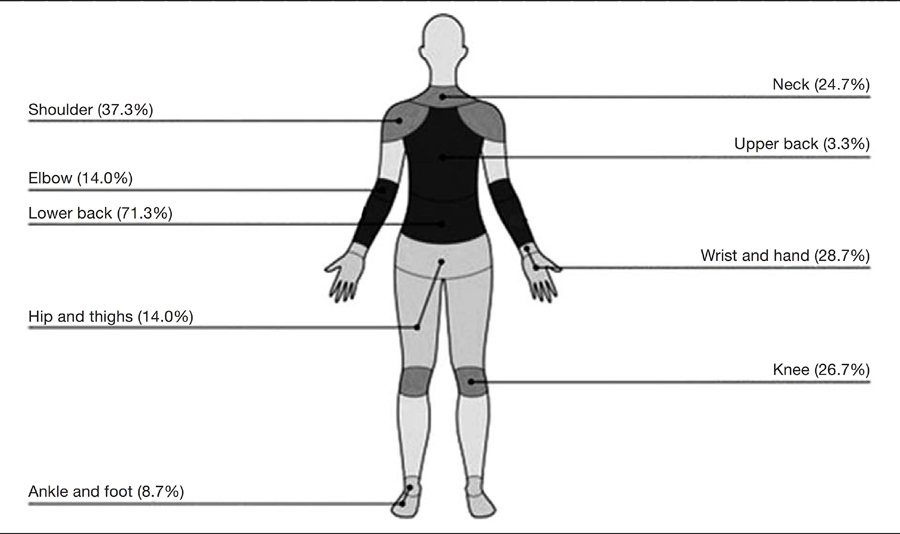Prevalence and Incidence of Musculoskeletal Extremity Complaints in Children and Adolescents. A Systematic Review
SOURCE: BMC Musculoskelet Disord. 2017 (Oct 18); 18 (1): 418
Signe Fuglkjer, Kristina Boe Dissing and Lise Hestbaek
Department of Sports Science and Clinical Biomechanics,
Faculty of Health Sciences,
University of Southern Denmark,
Campusvej 55, DK-5230, Odense M, Denmark.
BACKGROUND: It is difficult to gain an overview of musculoskeletal extremity complaints in childhood although this is essential to develop evidence-based prevention and treatment strategies. The objectives of this systematic review were therefore to describe the prevalence and incidence of musculoskeletal extremity complaints in children and adolescents in both general and clinical populations in relation to age, anatomical site and mode of onset.
METHODS: MEDLINE and EMBASE were electronically searched; risk of bias was assessed; and data extraction was individually performed by two authors.
RESULTS: In total, 19 general population studies and three clinical population studies were included with children aged 0–19 years. For most of the analyses, a division between younger children aged 0–12 years, and older children aged 10–19 years was used. Lower extremity complaints were more common than upper extremity complaints regardless of age and type of population, with the most frequent pain site changing from ankle/foot in the youngest to knee in the oldest. There were about twice as many non-traumatic as traumatic complaints in the lower extremities, whereas the opposite relationship was found for the upper extremities in the general population studies. There were relatively more lower extremity complaints in the general population studies than in the clinical population studies. The review showed no pattern of differences in reporting between studies of high and low risk of bias.
There are more articles like this @ our:
CONCLUSIONS: This review shows that musculoskeletal complaints are more frequent in the lower extremities than in the upper extremities in childhood, and there are indications of a large amount of non-traumatic low intensity complaints in the population that do not reach threshold for consultation. A meta-analysis, or even a simple overall description of prevalence and incidence of musculoskeletal extremity complaints in children and adolescents was not feasible, due to a large variety in the studies, primarily related to outcome measurements.
KEYWORDS: Incidence; Musculoskeletal injury; Musculoskeletal pain; Paediatrics; Prevalence
From the FULL TEXT Article:
Background
Recently, the Global Burden of Disease studies reported musculoskeletal pain as one of the leading causes of years lived with disability [1] and this constitutes a substantial burden on society. [2] Therefore, it is important to design better prevention strategies and early effective treatment. To do that, more basic knowledge about the epidemiology of musculoskeletal complaints in children and adolescents must be obtained first.
The epidemiology of spinal pain in children is well-described [3–5], whereas less attention has been given to musculoskeletal extremity complaints (MEC) in children. Furthermore, musculoskeletal problems in childhood might not only lead to musculoskeletal complaints in adulthood, but could also be a barrier for physical activity and thus have a negative influence on general health. [6] It has been shown that physical activity is important for health in children and adolescents [6–9], and in addition the amount of physical activity in childhood is considered to be a predictor of the amount of physical activity in adults [9], which is important in prevention of many lifestyle disorders, e.g. diabetes and cardiovascular disease. [8, 9]
Various terms have been used in relation to musculoskeletal extremity complaints (MEC), starting from the less severe ache to injury or more severe musculoskeletal disorders. Commonly, MEC are divided into traumatic and non-traumatic complaints, where a traumatic complaint has been defined as an injury resulting from a specific identifiable event, whereas a non-traumatic complaint is not related to an identifiable event. [10] In research of MEC, focus has traditionally been on either specific groups of athletes, or injuries reported at emergency departments, and patterns of paediatric injuries in relation to sport are therefore well described. [11–13] While this type of research provides valid information about specific injuries, mainly injuries of a traumatic onset, they do not represent the full picture of MEC in the general population. Specifically, none of these methods collect valid information about non-traumatic complaints in the general population, which has been shown to represent a large part, close to two thirds, of MEC. [14, 15]
The prevalence and treatment strategies of some types of specific injuries, e.g. fractures [16] and ankle distortions [17–19] are well described, but such knowledge has not been accumulated for many other types of musculoskeletal extremity complaints (MEC), e.g. overuse injuries and non-specific minor complaints. To inform the development of evidence-based prevention and treatment strategies, the first step is to increase knowledge about types and frequency of MEC in childhood. At present it is difficult to gain an overview of the extent of various types of complaints in relation to mode of onset (traumatic vs. non-traumatic), different anatomical locations and histological involvement. Therefore, the objectives of this systematic review were to investigate the prevalence and incidence of musculoskeletal extremity complaints in children and adolescents in both general and clinical populations in relation to age, distribution between different complaint sites, and types of complaints (traumatic vs. non-traumatic). Furthermore, differences between general and clinical populations will be explored.
Read the rest of this Full Text article now!







Leave A Comment